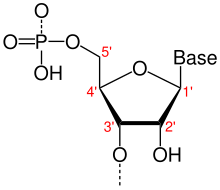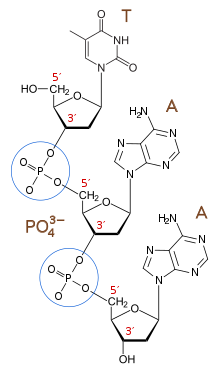Directionality (molecular biology)
This articleneeds additional citations forverification.(May 2023) |

Directionality,inmolecular biologyandbiochemistry,is the end-to-end chemical orientation of a single strand ofnucleic acid.In a single strand ofDNAorRNA,the chemical convention of naming carbon atoms in thenucleotidepentose-sugar-ringmeans that there will be a5′ end(usually pronounced "five-prime end" ), which frequently contains aphosphategroup attached to the 5′ carbon of theribosering, and a3′ end(usually pronounced "three-prime end" ), which typically is unmodified from the ribose -OH substituent. In aDNA double helix,the strands run in opposite directions to permitbase pairingbetween them, which is essential for replication ortranscriptionof the encoded information.
Nucleic acids can only be synthesizedin vivoin the 5′-to-3′ direction, as thepolymerasesthat assemble various types of new strands generally rely on the energy produced by breakingnucleoside triphosphatebonds to attach new nucleoside monophosphates to the 3′-hydroxyl(−OH) group, via aphosphodiester bond.The relative positions of structures along strands of nucleic acid, includinggenesand various proteinbinding sites,are usually noted as being eitherupstream(towards the 5′-end) ordownstream(towards the 3′-end). (See alsoupstream and downstream.)
Directionality is related to, but different from,sense.Transcription of single-stranded RNA from a double-stranded DNA template requires the selection of one strand of the DNA template as the template strand that directly interacts with the nascent RNA due tocomplementary sequence.The other strand is not copied directly, but necessarily its sequence will be similar to that of the RNA.Transcription initiation sitesgenerally occur on both strands of an organism's DNA, and specify the location, direction, and circumstances under which transcription will occur. If the transcript encodes one or (rarely) moreproteins,translation of each protein by theribosomewill proceed in a 5′-to-3′ direction, and will extend the protein from itsN-terminustoward itsC-terminus.For example, in a typical gene astart codon(5′-ATG-3′) is a DNA sequence within the sense strand. Transcription begins at an upstream site (relative to the sense strand), and as it proceeds through the region it copies the 3′-TAC-5′ from the template strand to produce 5′-AUG-3′ within amessenger RNA(mRNA). The mRNA is scanned by the ribosome from the 5′ end, where the start codon directs the incorporation of amethionine(bacteria,mitochondria,andplastidsuseN-formylmethionineinstead) at the N terminus of the protein. By convention, single strands ofDNAandRNAsequences are written in a 5′-to-3′ direction except as needed to illustrate the pattern of base pairing.
5′-end[edit]

The 5′-end (pronounced "five prime end" ) designates the end of the DNA or RNA strand that has the fifth carbon in thesugar-ringof thedeoxyriboseorriboseat its terminus. Aphosphategroup attached to the 5′-end permitsligationof twonucleotides,i.e., the covalent binding of a 5′-phosphate to the 3′-hydroxyl group of another nucleotide, to form aphosphodiester bond.Removal of the 5′-phosphate prevents ligation. To prevent unwanted nucleic acid ligation (e.g. self-ligation of aplasmid vectorinDNA cloning),molecular biologistscommonly remove the 5′-phosphate with aphosphatase.
The 5′-end of nascentmessenger RNAis the site at whichpost-transcriptional cappingoccurs, a process which is vital to producing mature messenger RNA. Capping increases the stability of the messenger RNA while it undergoestranslation,providing resistance to the degradative effects ofexonucleases.[1]It consists of amethylatednucleotide (methylguanosine) attached to the messenger RNA in a rare 5′- to 5′-triphosphate linkage.
The5′-flankingregionof ageneoften denotes a region of DNA which is nottranscribedinto RNA. The 5′-flanking region contains thegene promoter,and may also contain enhancers or other protein binding sites.
The5′-untranslatedregion(5′-UTR) is a region of a gene which is transcribed into mRNA, and is located at the 5′-end of the mRNA. This region of anmRNAmay or may not betranslated,but is usually involved in the regulation of translation. The 5′-untranslated region is the portion of the DNA starting from the cap site and extending to the base just before the AUG translation initiation codon of the main coding sequence. This region may have sequences, such as theribosome binding siteandKozak sequence,which determine the translation efficiency of the mRNA, or which may affect the stability of the mRNA.
3′-end[edit]

The 3′-end (three prime end) of a strand is so named due to it terminating at thehydroxylgroup of the third carbon in thesugar-ring,and is known as thetail end.The 3′-hydroxyl is necessary in the synthesis of new nucleic acid molecules as it isligated(joined) to the 5′-phosphate of a separate nucleotide, allowing the formation of strands of linked nucleotides.
Molecular biologistscan usenucleotidesthat lack a 3′-hydroxyl (dideoxyribonucleotides) to interrupt the replication ofDNA.This technique is known as the dideoxy chain-termination method or theSanger method,and is used todetermine the order of nucleotides in DNA.
The 3′-end of nascentmessenger RNAis the site ofpost-transcriptional polyadenylation,which attaches a chain of 50 to 250adenosineresidues to produce mature messenger RNA. This chain helps in determining how long the messenger RNA lasts in the cell, influencing how much protein is produced from it.
The 3′-flankingregion is a region of DNA that is not copied into the mature mRNA, but which is present adjacent to 3′-end of the gene. It was originally thought that the 3′-flanking DNA was not transcribed at all, but it was discovered to be transcribed into RNA and quickly removed during processing of the primary transcript to form the mature mRNA. The 3′-flanking region often contains sequences that affect the formation of the 3′-end of the message. It may also contain enhancers or other sites to which proteins may bind.
The3′-untranslatedregion(3′-UTR) is a region of the DNA whichistranscribed into mRNA and becomes the 3′-end of the message, but which does not contain protein coding sequence. Everything between thestop codonand thepolyA tailis considered to be 3′-untranslated. The 3′-untranslated region may affect the translation efficiency of the mRNA or the stability of the mRNA. It also has sequences which are required for the addition of the poly(A) tail to the message, including the hexanucleotide AAUAAA.
See also[edit]
Further reading[edit]
- Harvey Lodish; Arnold Berk; Paul Matsudaira; Chris A. Kaiser (2004).Molecular Cell Biology(5th ed.). New York City: W.H. Freeman and Company.ISBN978-0-7167-4366-8.
- ^Gao M, Fritz DT, Ford LP, Wilusz J (March 2000)."Interaction between a poly(A)-specific ribonuclease and the 5′ cap influences mRNA deadenylation rates in vitro".Molecular Cell.5(3): 479–488.doi:10.1016/S1097-2765(00)80442-6.PMC2811581.PMID10882133.
